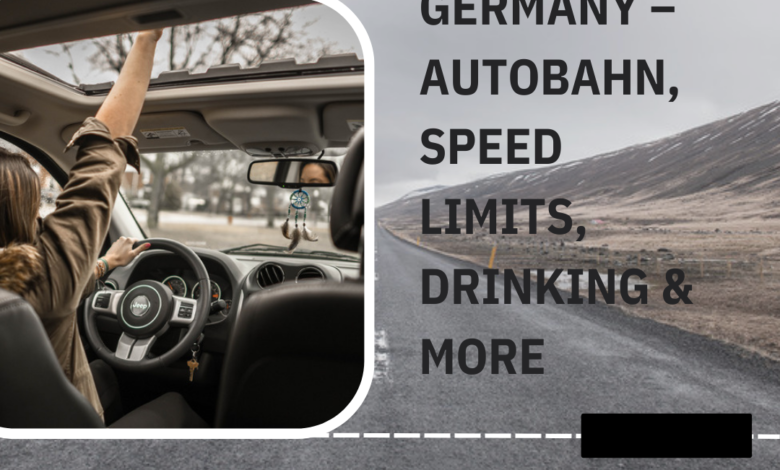Driving in Germany – Autobahn, Speed Limits, Drinking and More

Driving in Germany – Autobahn, Speed Limits, Drinking, and More
Driving in Germany – Autobahn, Speed Limits, Drinking, and More is the most crucial thing to know if you want to properly appreciate the lovely country of Germany for any length of time. The country features some of the world’s most magnificent landscapes, particularly its well-maintained road system. Speaking of the road system, it is one of the best in the world, with the world-famous Autobahn as a highlight, but it does not end there. The procedure for obtaining a driver’s license in Germany is simple, but it is detailed, and there are a few things you should be aware of.

The German Autobahn
Today’s Autobahn has its own set of regulations and conventions:
Speed: On the Autobahn, you are free to drive as fast as you feel safe (unless otherwise indicated); the German authorities propose a “recommended” speed of 130 kph (80 mph). Except where indicated, there is no speed limit on the Autobahn. Speed limits are displayed in construction zones and high-traffic regions, for example, so keep an eye out for these signs—speeding in restricted places on the Autobahn might result in a large fine.
Passing: In the left lane, you can only pass another car. The right lane is for slower vehicles, and it is unlawful to overtake cars in the right lane. This is strictly followed, unlike in the United States.
Take a close look: Check your rearview mirror attentively before pulling into the left lane to pass another car—some cars travel at speeds of up to 200 kph and approach quite quickly. If a car approaches from behind and flashes its lights, it signals “get out of the way,” and you should move to the right.
Stopping: On the Autobahn, you are not permitted to stop, back up, or make a U-turn. And running out of gas is both unlawful (because you are not permitted to stop) and avoidable.
Take a Break: Driving on the Autobahn is exhausting, so take a break every 100 kilometers or so. Rest spots have been erected every 40 to 60 kilometers on the highways.
Who can drive in Germany?
In Germany, everyone above the age of 18 with a valid driver’s license is permitted to operate a motor vehicle. As a result, even if you have a driver’s license in your home country, you will be unable to drive in Germany if you are 17 or younger.
- Nationals of the European Union (EU) and the European Economic Area (EU plus Iceland, Norway, and Lichtenstein) can use their foreign driver’s license in Germany.
- Everyone else can drive in Germany with their foreign driver’s license for the first six months, but after that, non-EU/EEA citizens must extend or exchange their license for a German license, which may require a written exam or a driving test.
- You are allowed to drive your car in Germany for up to 12 months before having to register it with the German authorities.
Driving in Germany: A Checklist
- Driver’s License from the United States of America (required)
- The International Driver’s Permit is a document that allows you to drive across international borders (recommended)
- Insurance Certificate Proof (required)
- Passport/Identification Document (required)
- warning triangle (required in all vehicles with four wheels or more)
- A reflective safety vest (required)
- First aid kit (required)
- Beam deflectors (required if you cannot deflect headlights manually)
Speed Limits in Germany
Unless otherwise indicated, the speed limit in all urban areas is 50 km/h. Outside the city limits, 100 km/h is the standard speed. On roads and highways, the maximum speed limit for drivers towing a trailer behind a car is 80 kilometers per hour (autobahns).
The highway itself has no speed limit, allowing speed enthusiasts to safely enjoy the full strength of Europcar’s fleet. Perfect for taking a scenic drive in the daylight in a brand new automobile rental!
Legal Alcohol Limit
For novice and professional drivers, the legal alcohol level is zero. The limit for other drivers will be 0.05 grams per liter of blood. However, it is normal practice not to drive at all if you have consumed any alcoholic beverage.
Parking
In some regions of the country, parking is extremely tough to come by. To prevent getting a penalty, pay attention to parking signs. Round signs with red borders, blue backgrounds, and the X indicate no parking or stopping at all. There is a restriction of three-minute parking; if the sign has a single diagonal line rather than an X. Any type of car is forbidden where there is a red border with white in the center.
Drinking and Driving in Germany
In Germany, there is a computerized point system that severely punishes intoxicated drivers. Even though there aren’t any specific speed limits, the nature of German traffic necessitates constant caution. On German roads, there is a lot of trade, and a driver can expect to see a combination of fast-moving vehicles and slow-moving trucks. Even if there is no stated speed restriction on the highway, insurance firms maintain the authority to refuse payment on any insurance claim involving an accident on a German highway at speeds above 130 km/h.
Although you drive on the other side of the road in Germany, most of the rules are the same as they are in the UK, so things like roundabouts and intersections are the same. Driving in Germany is pleasant.
Visit for more information:
How to Study in Germany for Free-Everything You Need to Know
